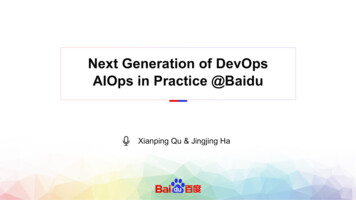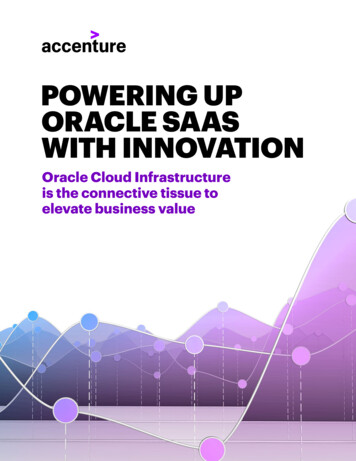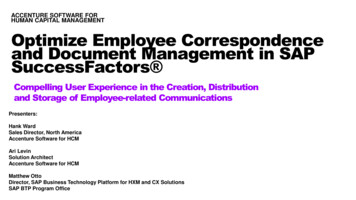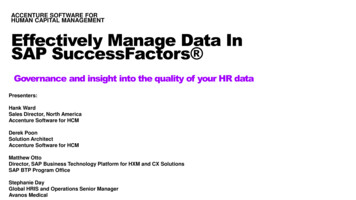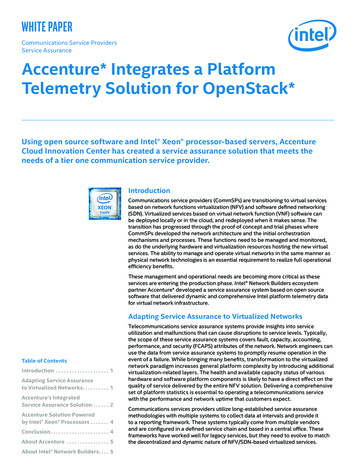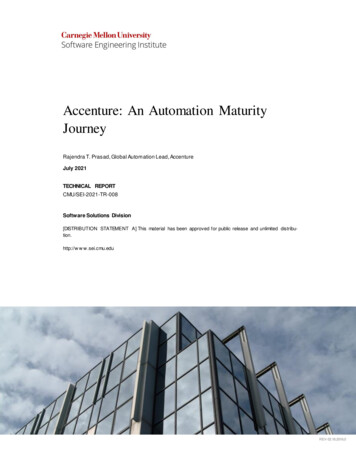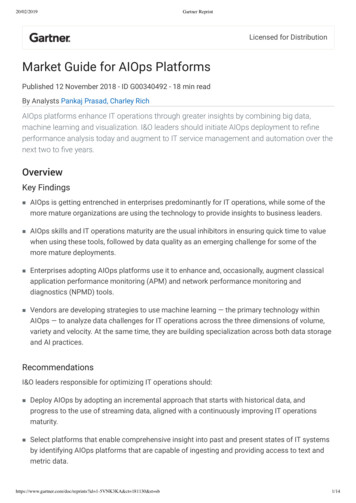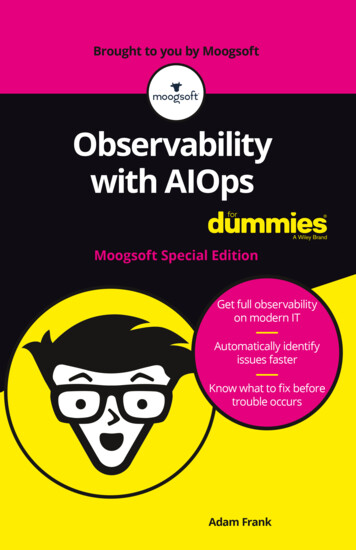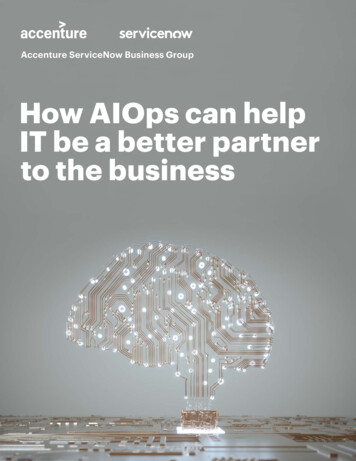
Transcription
How AIOps can helpIT be a better partnerto the business
IT’s worst nightmareAn order processing department in a very largeenterprise is dependent on a business servicesupported by IT resources in both the datacenter and the cloud. The service is usuallyquite responsive—something the IT organizationis proud of—but suddenly one day it starts toget sluggish. Over the next few days, the servicegets increasingly slow and, finally, simplyshuts down. It’s a major crisis—after all, orderprocessing is in many ways the heartbeat ofany company. The business will take a huge hitif it can’t quickly and efficiently get customerswhat they want.The preceding anecdote, while hypothetical,is based on the reality that all IT leaders grapplewith on a daily basis: the fear of constantly missingService Level Agreements (SLAs) and major ITfailures that have a material impact on the business.IT leaders know that such failures impede theirability to achieve their most critical overarchinggoal: building and sustaining the business’s trustin the IT organization.Meeting SLAs, addressing outages and servicedegradations are just one of the few issues thatartificial intelligence for IT operations (AIOps)addresses.The IT organization needs to move fast to determinewhat went wrong and get the service back online.But that’s not easy. Literally thousands of eventscoming from siloed monitoring systems are nowflooding the IT operations team, who have to sortthrough every event to find the needle in thehaystack—the handful of issues that are the rootcause of the business service failure. Because theteam is using legacy IT operations tools and largelymanual processes, it takes eight hours—a fullbusiness day—to first figure out on which serversthe service is running, and to eventually pinpointthe cause.A major factor in gaining and keeping the business’strust is continually improving the IT organization’sefficiency and responsiveness. The technologyand business worlds are evolving rapidly, and theIT organization itself must ensure it can keep pace.Trust also hinges on the technologies themselves.IT leaders need to continually evaluate thetechnologies they provide to the business—retiring antiquated, outdated tools that no longerserve the business and, in fact, may be holdingit back.8hrs02How AIOps can help IT be a better partner to the business
Lagging behind the businessToday IT leaders find these goals difficult toconsistently achieve. In fact, serving the businesseffectively and efficiently, while never truly “easy”in the past, has become exponentially hardertoday—for two big reasons: complexity and speed.In addition to growing complexity, the businessis innovating more quickly than ever. By adoptingcloud-first strategies, digital transformation, andDevOps, in parallel, organizations can innovatevery quickly. Just look at ever-accelerating softwaredevelopment cycles.In large organizations, operational complexityand scale are skyrocketing.7 in 1048%40%Most big companies—about 7 in 10—now runmultiple cloud environments in addition to theiron-premise data centers.1 And in 40 percent ofthose cases, there’s low interoperability acrossthose cloud environments.1 Application andinfrastructure problems are hard to find in suchcomplex, distributed, and typically disconnectedenvironments, and failures due to this complexityresult in significant, but avoidable, costs.03How AIOps can help IT be a better partner to the businessNearly half of companies that employ DevOpsrelease new code monthly or weekly.1 Companiesare churning out new digital products and servicesso fast that IT operations teams can no longer keepup with the business units they support.
Best practices foradopting AIOps:From cost centerto business partnerAIOps can dramatically improve the IT organization’sability to be an effective partner to the business.An IT operations platform with built-in AIOpscapabilities like ServiceNow can help IT operationsproactively identify potential issues with the servicesand technology it delivers to the business andcorrect them before they become problems. Andwhen there is a service outage, the platform filtersout all the unnecessary events and only presentsthe critical few in a single console in the contextof the affected service; and also provides thehistorical incidents and changes associated withthe infrastructure and applications services itemsin question—which it gets from the platform usingmachine learning (see next page). That’s the valueof having a single data model that service andoperations management applications canshare seamlessly.Think back to the scenario we discussed above.How would that company’s experience have beendifferent with AIOps? Instead of its IT operationsteam having to manually sort through thousandsof events from its data centers and cloud estatesflashing across dozens of siloed monitors, a machinelearning engine does it for them in the background,and much faster. It then presents to the team, via asingle console, the few critical alerts that are actuallyrelated to the cause of the problem and the prioritybusiness services that are affected. In this instance,the engine also can automatically kick off theremediation process with no human intervention—getting the problem fixed and the order processingsystem back online in a matter of minutes, insteadof the full day it took with legacy tools and manualprocesses.04How AIOps can help IT be a better partner to the businessPriority
Machine learning’s role in alert managementThe number of alerts handled by IT operationsteams and tools has become overwhelming—even with the increasing use of rules-based eventprocessing. That’s why the machine learningcomponent of an AIOps platform is so important.Machine learning can create alert groups thatcontain related alerts based on historical alertdata, so instead of seeing individual symptoms,IT operations professionals see a single underlyingissue with its list of associated symptoms.Take, for instance, an alert for an applicationwhose processes are consuming too many systemresources. Initially, the alert may be a low priority.But, if the condition persists and gets worse, it canlead to the host server running out of memory oroverloading its CPU, which creates a critical alert.Machine learning identifies these temporal alertpatterns, analyzing historical alert data to look forrepeating sequences. When it identifies the samepattern in current alerts, it groups these alertsand displays them on a timeline. Not only doesthis reduce noise, it also dramatically simplifiesdiagnosis because professionals can see howthe pattern unfolds.05How AIOps can help IT be a better partner to the businessIn addition to understanding historical temporalalerts, machine learning also uses its knowledge ofhow a company’s IT environment is interconnectedto learn how symptoms—and correspondingalerts—propagate across the infrastructure andbusiness services. An example of this is identifyingthe upstream symptoms of an unresponsive webserver supporting a business service. UpstreamCIs that depend on the web server are affectedand generate alerts. Machine learning understandsthe relationships between these CIs and uses thisinformation in concert with the arrival time of thealerts to group the alerts.However, while machine learning excels atidentifying patterns, it still needs feedback toimprove the model accuracy over time. Operatorsprovide such feedback when they add or deletealerts in automatically generated alert groups.The machine learning engine sees and learnsfrom these changes, and uses this knowledgeto improve its future alert grouping behavior.
With a cloud-based platform incorporating AIOps capabilities, IT organizations gain the tools and insightsthey need to move IT from being a cost center to a true partner to the business without having to upgradeand integrate existing IT operations tools and data, deploy a machine learning solution, and add a hugenumber of additional staff to its IT operations team—all of which would be financially unfeasible. AIOps:Gives IT leaders complete, up-todate visibility across their entire IToperations estate—on-premise andcloud. Because fostering and maintainingthe business’s trust in IT is one of the ITorganization’s biggest concerns, it’scritical for the IT organization to be ableto keep the systems and applications thebusiness depends on up and running.AIOps enables IT to keep tabs on what’shappening across the business, in realtime, with the same level of staffing.Enables IT to proactively identifyservice health issues, and then quicklypinpoint and remediate the root cause.Nothing erodes trust in IT as much as anapplication failure. With AIOps, IT canavoid being surprised by a criticalapplication or infrastructure going down,and identify and fix potential issues beforethey become big problems.Helps IT leaders optimize their spendon cloud usage and software so theycan provide what the business needs,when it needs it. Spending money ontechnology to support the business is alot like the Goldilocks conundrum: Toolittle, and the business can’t do what itneeds to do to continue to grow and becompetitive; too much, and money’sbeing wasted that could be put to betteruse. AIOps methodologies help ITorganizations ensure that what theyspend on technology is “just right.”Companies are gaining significant quantifiableresults deploying AIOps with ServiceNowKey IT ObjetivesEnhance Trust in ITImprove Operational EfficiencyRetire Archaic ToolsAIOps PlatformEstablish complete visibility acrossyour operations estate06Deliver businessservice healthHow AIOps can help IT be a better partner to the businessOptimize spend on cloudusage and software
These benefits are reflected in the real-worldexperiences of three different companies,each of which have generated significant,quantifiable results from an IT operationsmanagement platform with built-in AIOpscapabilities like ServiceNow.One of these organizations is a Fortune50 global aerospace company, whichchallenged itself to hit an aggressiverevenue target. The problem was,it was saddled with siloed legacy systemsand many manual processes, as well assignificant technical debt due to sprawlingshadow IT. The ServiceNow platform’sAIOps capabilities enabled the companyto cut IT overhead by 47 million andimprove IT productivity 22 percent, thuspositioning the IT organization to supportthe company’s anticipated growth.Another company, a Fortune 100 chemicalbusiness, wanted to increase its legacyIT environment’s reliability to accelerateservice-driven change. But its legacyservice management capabilities couldn’tbe easily upgraded or extended in linewith the company’s strategy, and its legacyservice management tool wasn’t alignedwith IT priorities and goals. The companyused ServiceNow to reduce the meantime to resolution and to populate itsCMDB which, in the process, improvedIT productivity by 80 percent.The third company, a global financialcorporation, was focused on boosting itsIT organization’s productivity and neededautomation to do so. But its robotic processautomation, machine learning, and artificialintelligence solutions were disaggregatedand the company had no way to connectthem. Using the ServiceNow platform tointegrate these solutions, the companyincreased overall IT productivity by 5percent and reduced mean time toresolution of incidents by 11 percent.07How AIOps can help IT be a better partner to the businessIs your organizationready for AIOps?Here’s how to getstarted.As the preceding examples demonstrate,AIOps can help the IT organizationdramatically improve service health,responsiveness, efficiency and productivity.However, while powerful, AIOps alsointroduces significant change, both in theIT operations tools and processes usedand in the prevailing IT culture. Peopleare comfortable with the tools they know,and can be resistant to automating whatthey’ve traditionally done by hand.That’s why companies considering amove to AIOps should start small. Insteadof introducing an AIOps platform across allof IT operations and retiring existing tools inone big bang, they should look for specificpockets of work where they could get anend-to-end process up and running onthe platform. Doing so will enable the ITorganization to quickly demonstrate resultsthat will encourage others to adopt theplatform, while minimizing the risk ofdisrupting an area of the IT organization’swork that’s critical to the functioning of thebusiness. For example, often the low-hangingfruit a pilot can capture is to discover thephysical topology and dependencies ofa specific business service.Importantly, such pilots should includeboth the IT organization and representativesfrom the business, collaborating closely onimplementation to maintain the business’strust that the IT organization has worked sohard to build.Today’s companies are changing rapidly,driven by evolving customer expectationsand intense competition most have neverexperienced. AIOps can help IT organizationsensure that they can be there when thebusiness needs them and not get left behind.
References1"The Journey Towards Optimized IT Operations," IDCand ServiceNow InfoBrief, November 2018About AccentureAccenture is a global professional services companywith leading capabilities in digital, cloud and security.Combining unmatched experience and specializedskills across more than 40 industries, we offerStrategy and Consulting, Interactive, Technologyand Operations services—all powered by the world’slargest network of Advanced Technology andIntelligent Operations centers. Our 674,000 peopledeliver on the promise of technology and humaningenuity every day, serving clients in more than120 countries. We embrace the power of changeto create value and shared success for our clients,people, shareholders, partners and communities.Visit us at accenture.com.About ServiceNowServiceNow (NYSE: NOW) is making the world ofwork, work better for people. Our cloud-basedplatform and solutions deliver digital workflows thatcreate great experiences and unlock productivity foremployees and the enterprise. For more information,visit: www.servicenow.com.Copyright 2022 Accenture. All rights reserved.Accenture and its logo are trademarks of Accenture.
cause of the business service failure. Because the team is using legacy IT operations tools and largely manual processes, it takes eight hours—a full business day—to first figure out on which servers the service is running, and to eventually pinpoint the cause. 02 How AIOps can help IT be a better partner to the business 8 hrs
